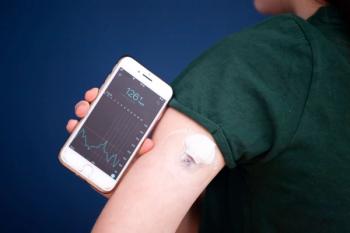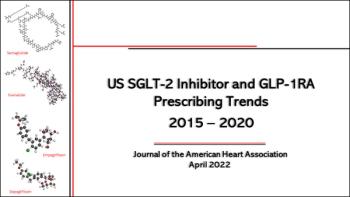
ADA 2022: Tirzepatide, a GIP/GLP-1 receptor agonist, reduced a composite of kidney events in patients with type 2 diabetes and at increased cardiovascular risk in an analysis of SURPASS-4.


Empagliflozin More Effective to Reduce Risk of Heart Failure Hospitalization vs DPP-4 Inhibitors, GLP-1 Receptor Agonists

ADA 2022: Tirzepatide, a GIP/GLP-1 receptor agonist, reduced a composite of kidney events in patients with type 2 diabetes and at increased cardiovascular risk in an analysis of SURPASS-4.

DiabetesWise Pro lets clinicians compare diabetes devices for a specific patient and provides the steps for ordering the device based on insurance type.

The Abbott FreeStyle Libre 3 is the smallest, thinnest, and most accurate 14-day CGM with a 7.9% MARD, the company says.

Initiating T2D treatment with an SGLT2 inhibitor reduced risk for heart failure hospitalization compared to metformin in a new study; cardiovascular outcomes were similar.

The USPSTF is rumored to have moved screening for chronic kidney disease to a preventive service it is actively considering and the NFK says, "It's time."

Kosiborod, a cardiologist, and Skolnik, a family practitioner, agree no single specialty owns that prescription and that "it takes a village to care for a patient."

Among more than 3000 participants with prediabetes, neither metformin or lifestyle change reduced risk for CV events over 21 years according to Diabetes Prevention Program Outcomes Study investigators.

Compare, contrast, price shop, prescribe. DiabetesWise Pro developer Korey Hood, PhD, highlights the tool all primary care clinicians should try.

In adults with type 2 diabetes seen in primary care, lowering glucose substantially during the first 12 months post-diagnosis decreased risk for future MACE.

Mikhail Kosiborod, MD, a cardiologist and Neil Skolnik, MD, a primary care physician, agree that whoever is seeing the patient should prescribe the drug that is needed.

Tirzepatide, a novel once-weekly GLP-1/GIP mimetic that binds to receptors and stimulates glucose-dependent insulin release, has shown superiority over many common antihyperglycemics.

A study of the most genetically diverse collection of DNA from persons with T2D yields 40 new potentially causative genes that may transcend ancestry.

Lowering thresholds for BMI value and age of first diabetes screening among large US minority populations could greatly increase rates of diagnosis and improve care.

HbA1c levels over time were found higher at initiation of second-line treatment in veterans aged 55 years and younger, a trend unsettling to a new study's lead author.

SAMPLE: What was the first FDA-approved CGM system to include a fully implantable sensor to detect glucose?

Initiation of second-line type 2 diabetes treatment is lagging while A1c at the time it is introduced is climbing. The author of a new study highlights his findings on clinical inertia.

PCPs and internists accounted nationally for 57% of SGLT2i and 52% of GLP1RA prescriptions in 2020, more than any other specialty, according to new research.

Treatment with intranasal insulin improved executive function and verbal memory, as well as other measures, in participants with and without type 2 diabetes.

The ONWARDS 2 trial achieved its primary endpoint of demonstrating non-inferiority in reducing HbA1c at week 26 with insulin icodec vs insulin degludec.

Dr Diana Isaacs provides insight on current challenges in the clinical treatment of patients with diabetes and shares clinical pearls for the use of CGMs in disease management.

Diana Isaacs, PharmD, BCPS, BCACP, BC-ADM, CDCES, evaluates upcoming CGM advances in the pipeline for the management of diabetes.

Researchers developed polygenic risk scores for 6 common diseases and informational resources to help primary care physicians incorporate them into clinical practice.

The NDA for daprodustat, a novel investigational agent, is based on data from pivotal ASCEND program clinical trials.

Dr Diana Isaacs reviews the significance of Eversense’s recent approval for a 180-day indication and the potential role of Dexcom G7 in the diabetes treatment landscape.

Diana Isaacs, PharmD, BCPS, BCACP, BC-ADM, CDCES, comments on the accuracy and selection of CGMs in treating diabetes and shares insight on the evolution of CGM systems over the past year.